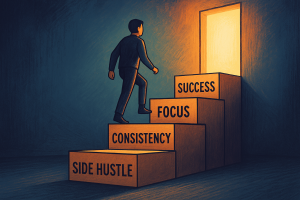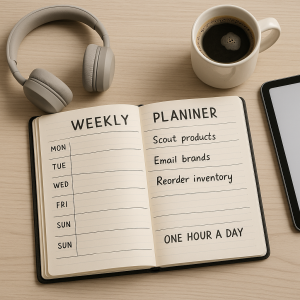By Dan & Dylan, The Wholesale Formula
Over the past decade, we’ve helped thousands of people take their first steps into wholesale.
Many started as busy parents, full-time employees, or even college students.
 Yet, with as little as an hour a day, they’ve built thriving ecommerce businesses that have changed their lives. Together, we’ve managed over $40 million in Amazon revenue using systems that work, even if you’re strapped for time.
Yet, with as little as an hour a day, they’ve built thriving ecommerce businesses that have changed their lives. Together, we’ve managed over $40 million in Amazon revenue using systems that work, even if you’re strapped for time.
But we know what it’s like to be where you are. Dylan and Dan were there once.
Dylan’s Story: From Comfortable to Committed
When Dylan first started exploring ecommerce, he was working what many in his small Kentucky town considered a “dream job.”
He had a secure position at a local college, earning more than most of his friends and neighbors. For a rural area, it was great pay.
It felt safe, predictable, and easy to justify staying put.
The idea of starting an Amazon business seemed exciting, but it also felt risky. Nearly everyone around him thought so too.
His family told him to stay in his 9-to-5. “You’ve got benefits,” they reminded him. “Don’t mess that up by chasing some online thing.”
Even friends warned him not to rock the boat. It was tempting to agree, especially since his job wasn’t awful. In fact, the steady paycheck made it even harder to imagine stepping outside his comfort zone.
Dan’s Story: From Crisis to Commitment
Dan’s journey was different.
 Right before Christmas one year, he unexpectedly lost his job. With a baby daughter at home and his wife staying home to care for her, he felt a wave of fear and uncertainty.
Right before Christmas one year, he unexpectedly lost his job. With a baby daughter at home and his wife staying home to care for her, he felt a wave of fear and uncertainty.
The timing couldn’t have been worse, and the weight of providing for his family sat heavy on his shoulders.
Instead of scrambling for another job, Dan made a bold decision. He committed 100% to building his fledgling Amazon business.
It wasn’t easy in the beginning. There were long nights, mistakes, and moments of doubt. But he kept going, driven by the vision of creating a better life for his family.
In time, his dedication paid off.
What started as a desperate move turned into a thriving business, giving him the freedom to work on his terms and provide more than he ever imagined. Today, Dan helps others take that same leap with confidence.
Why One Hour a Day Works
The biggest misconception in ecommerce is believing you need 12-hour days to make real progress. You don’t.
What you need is focus.
When you dedicate one focused hour each day to the right tasks, you create momentum. Progress compounds. Before long, you’ll find yourself with a business that feels less like a side hustle and more like a serious venture.
We’ve seen countless sellers take small daily actions and grow into six- and seven-figure businesses. It’s not about doing everything.
It’s about doing the right things.
The 7-Day Power Hour Plan
Here’s how to break your time into focused sessions for maximum growth.
 Day 1: Scouting Products (60 min)
Day 1: Scouting Products (60 min)
Your business starts with what you sell. On day one, focus your hour entirely on research.
Look for brands you already know and trust. Spend your hour browsing store shelves, online listings, or even your own pantry. Aim to find 10-15 potential brands that make products people buy over and over again. Consumables like vitamins, pet supplies, or kitchen staples for example.
Log your findings in a spreadsheet and note products that already perform well online. Check their reviews, their rank, and competition. Resist overthinking—your goal is progress, not perfection.
Quick Tip: A product that solves a problem and sells consistently is a great starting point.
Day 2: Emailing Brands (60 min)
Now that you have a list of potential winners, it’s time to make contact. Draft a simple email introducing yourself and your ecommerce business. Keep it professional yet approachable.
Use your hour to send outreach emails to 5-10 brands, asking about wholesale opportunities. Track your communications in your spreadsheet so you can follow up later.
What if they don’t respond? Don’t assume rejection. Follow up politely within 5-7 days. Many sellers give up too soon, but persistence pays off.
Day 3: Placing Test Orders (60 min)
Once you get a positive response, it’s time to take action. Use this hour to place small test orders with 1-2 brands. A test order could be as little as 10-25 units.
This is where you confirm product quality and demand. Set reminders for when the inventory arrives, and prepare to monitor performance.
Pro Tip: Start small to minimize risk, but don’t hesitate to scale up once you see results.
 Day 4: Maintaining Your Seller Account (60 min)
Day 4: Maintaining Your Seller Account (60 min)
Now shift your attention to your Amazon account. Spend your hour ensuring your storefront is healthy and functioning.
Log into Seller Central and check for:
- Stranded or suppressed listings
- Pricing adjustments for products that aren’t moving quickly
- Customer messages or alerts needing immediate attention
Focus only on urgent or high-priority notifications. Avoid going down unnecessary rabbit holes.
Solution: Streamline by handling only the essentials until you have more time or can outsource.
Day 5: Reorders and Supplier Growth (60 min)
Time to double down on what works. Review your sales data from test buys and reorder top performers before inventory runs out.You will repeat this every 4-6 weeks with your highest ROI products.
Also, look at your current suppliers—are there other SKUs they offer that could be profitable? Use the remaining time to email a few additional brands to expand your supplier network.
This is how you scale intentionally without overwhelming yourself.
Day 6: Strengthening Brand Relationships (60 min)
Your relationships with suppliers are your greatest asset. Spend an hour following up with brands you’ve already ordered from. Share positive results from your test buy, like how quickly you sold through your initial stock.
Ask about new products or exclusive opportunities. Building trust and rapport can lead to better pricing and priority stock.
Can’t meet in person? A friendly phone call or Zoom meeting can create a personal connection that most sellers overlook.
Day 7: Delegation and Planning (60 min)
As your business gains momentum, you’ll need to free up your time. Use your hour today to identify tasks you could outsource, like data entry, product research, or email follow-ups.
Research virtual assistants (VAs) who can take these off your plate. Even 5-10 hours of VA support a week can let you focus on strategy.
End your session by planning your next week based on what’s working and where you need to focus.
What If You Only Have 20 Minutes?
Some days, even an hour is a stretch. When that happens, use this simple prioritization system:
Focus First On:
- Checking Seller Central for urgent account or inventory issues
- Reordering top-selling products
- Sending one quick outreach email to a new brand
If Time Allows:
- Scout 1-2 new products
- Follow up with brands from last week
Save For Later:
- Organize spreadsheets or documents
- Research virtual assistants
Even 20 minutes a day can move your business forward when spent on the right things.
A Sample Weekly Calendar
 Here’s what a full week could look like for someone growing their business part time:
Here’s what a full week could look like for someone growing their business part time:
Monday: Scout 10-15 potential products (60 min)
Tuesday: Email 5-10 brands about wholesale opportunities (60 min)
Wednesday: Place test orders and track them (60 min)
Thursday: Maintain Seller Central account (60 min)
Friday: Reorder top performers and email 2 new suppliers (60 min)
Saturday: Build relationships with existing brands (60 min)
Sunday: Plan your next week and research VAs (60 min)
Remember, consistency is far more important than intensity.
Overcoming Common Roadblocks
You might hit challenges along the way, but there’s a solution for each one.
“I don’t know which products to sell.”
Start with brands you use and love. Focus on items people buy repeatedly, like supplements, snacks, or pet products.
“Brands aren’t responding to my emails.”
Follow up 2-3 times. If that fails, try calling—the personal touch sets you apart.
“I’m overwhelmed by Amazon details.”
Handle critical tasks first. As soon as possible, delegate repetitive work to a VA.
“I don’t have time.”
Use the prioritization matrix for 20-minute days. Schedule your daily “Power Hour” like an appointment.
Why Now Is the Time to Start
Dylan and Dan both could have played it safe, but they chose to act. You can too.
The wholesale landscape is evolving, but the opportunity has never been better for sellers willing to take consistent action. There is no “perfect time” to start. The sellers who succeed are the ones who act.
Think of it as Ready. Fire. Aim.
Don’t wait to have it all figured out. Start now, and adjust as you go.

Leave a Reply